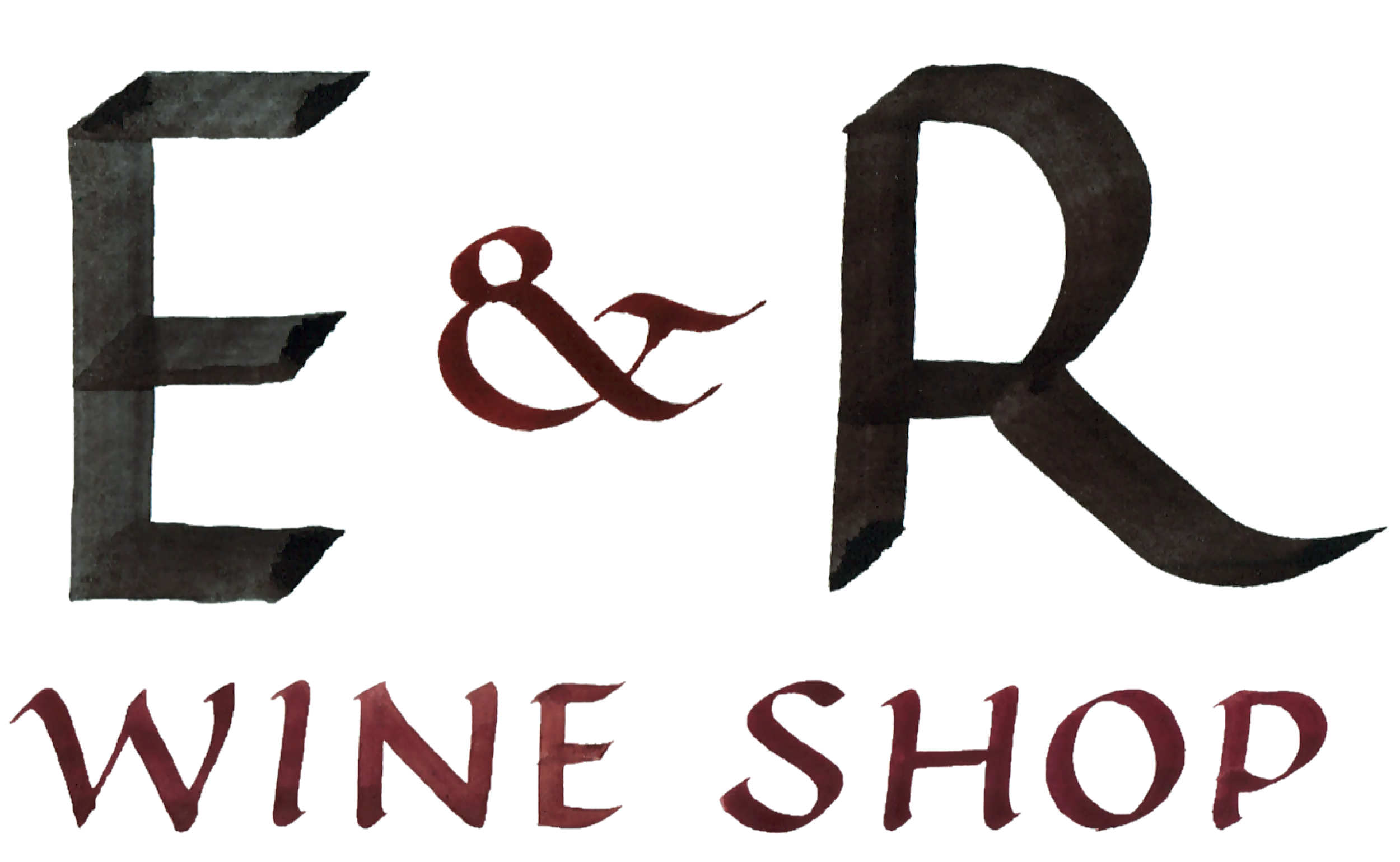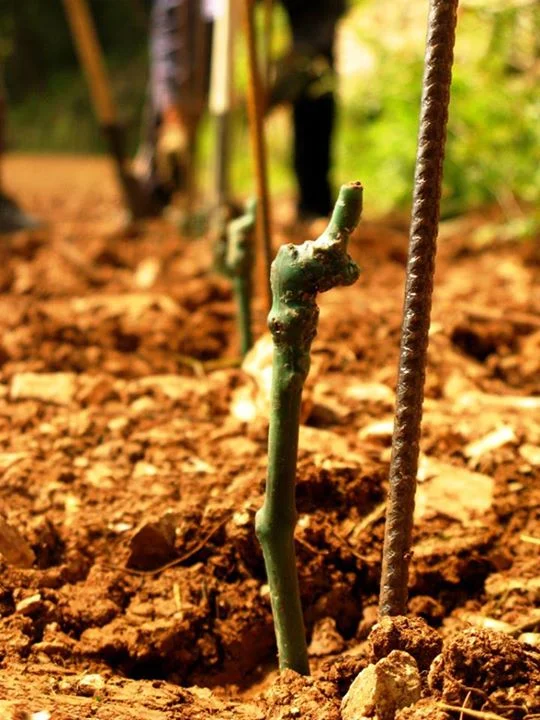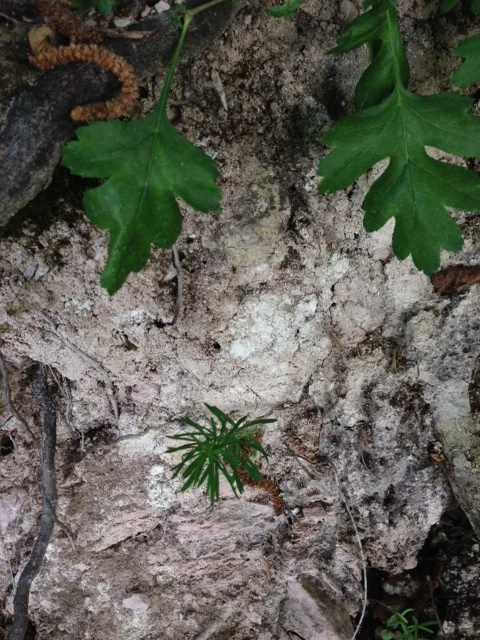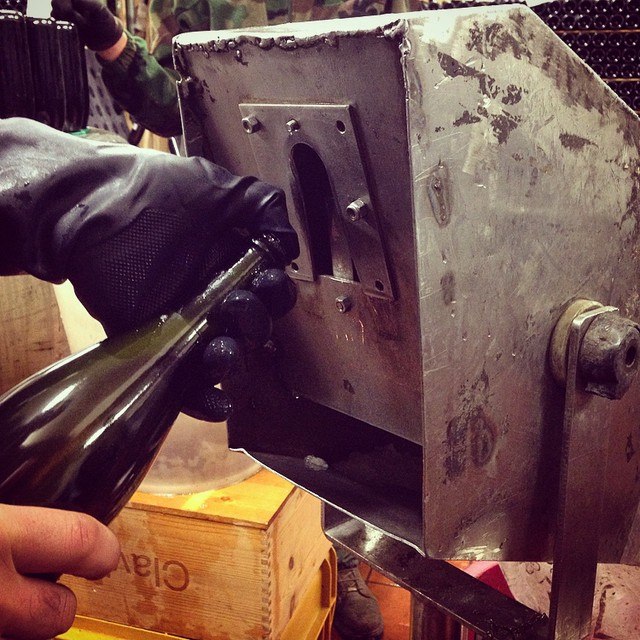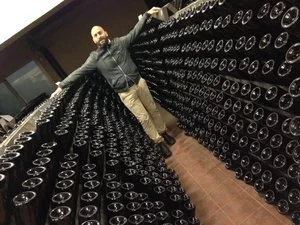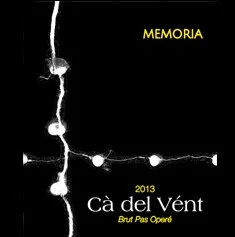Ca Del Vent - Lombardia, Italy
Antonio Tornincasa
(FANTASTIC) SPARKLING WINE FROM ANOTHER WORLD
(Editorial note: The heart of this 2013 article is as crucial today as then. Of course we adore well made sparkling wine from anywhere, but this story is very important and we believe region-changing. This is a lengthy article and there is much going on with their philosophy and their terroir. The story is big and we've done our best to to portray it along with a sense of the place, the people, the wine and its significance. Since this article, team E&R has made five visits to the winery, helped bring in over a dozen various sparkling wines from Cá del Vént and has stock of several of the newest releases in America.)
PLANET EARTH:
Lots of land,
Lots of people,
Some with greater reach...
Of all the babies ever born, only one of them was Johann Sebastian Bach.
Then there is the earth, the land.
Think about it, go way back — before man.
It was a field, a hill, a slope, a forest, a river, a pile of rocks.
Fast forward to today.
What's there in those spaces?
An intersection?
A condo?
Nothing at all?
A vineyard?
And if it is a vineyard, is it a "good" one? The soil? The exposure? The climate? And in whose care is it? Does it belong to a farmer selling grapes? Someone making their own house wine? Does it belong to a winemaker? Does it belong to Jean-Louis Chave? Was it purchased by AXA Insurance?
The hills of Brescia.
Are they trying to make Pinot noir "to taste like Burgundy"? Are they making Chardonnay in an oaky style for broad appeal?
Are they in a place perceived to be
unable to produce great wine?
These guys are in Cellatica.
Where?
In Lombardia???
You know, north/central Italy...
Mm hmm, right...
Are they making sparkling wines
to "be like Champagne":
NO! NO! NO!
CÀ DEL VÉNT; AHEAD OF THE CUTTING EDGE
Where parts of the story began.
Let our story begin here on a blustery, wintery day- with Antonio Tornincasa in the high hills at Campiani di Cellatica. It was chilly and darkish, with a sense of nature brooding on that afternoon; a weighty January 2013 day. The rich brown Lombardian earth stuck to our shoes, the heavy air, thickish, so much so the hills merge to ground-touching cloud already. Just a mere three terraces down the small vineyard and nothing could be seen of the land that day.
We are walking literally on the edge, the border of the famed appellation of Lombardia's Franciacorta. Here, deep into the plush Brescian hills — the part no one comes to — a part of no wine fame: the land is too hard to work, too tough, too high, too much trouble. We walk the newly reconditioned terraces, the very same space where men farmed grapes and made wine in century number Ten.
Here, across the vines, in those newly vacant places, little sticks are stuck in the soil. In a way, we are here on the edges; those ancient, and those contemporary... NO, we are perilously ahead of contemporary. It's a wine no-mans land where the future is no longer what it has always appeared to be. It's not a common situation: the time in Cà del Vént does not reflect the current spirit of the appellation, nor does the place have any similarity to the typical Franciacorta landscape. At Cà del Vént there is a jagged boundary in both time and space. This is the edge. This is the border. After all, fifteen steps the other way and you are then outside the DOCG of Franciacorta.
“Leave this be for the others- those lesser soils down there, plant the grape vines here atop this hill"
CÀ DEL VÉNT, NAPOLEON AND THE TRIPLE PLAY OF IMPORTANCE OF PLACE
The name "Cà Del Vént" translated from the original Italian, "Casa del Vento" refers to a "house of wind". This seemingly insignificant name is in fact very important today. Founded in 1994, Cà Del Vént, born from pure passion to produce singular wines is situated in what is arguably Franciacorta's most geographically, geologically unique enclave. In the early 1800's when Cellatica was part of the Kingdom of Italy, Napoleon mandated a civilian registrar to include all of Lombardia's residents. The now historic registry shows one of the old buildings at Cà Del Vént was named by farmers long, long before; it was called the "house of wind."
That's important, as Cà Del Vént and its vineyards are perched on a wide crescent (see foreground of photo #2 above) at the edge of, and atop, the whole of Franciacorta to the west. There is no other place quite like it in the zone. Named after the perennial wind constantly sweeping the hills, its effect allows for consistent freshness and cooler temps in these particular vineyards.
There is a kind of small plague infecting most of Franciacorta (though few would admit it): the stagnant air filling the valley/bowl that comprises much of its vineyard lands. Some even suggest large parts of the valley's soils (the majority of the whole region) are poisoned from decades of chemical treatments, and of both windblown and water-carried sprays to kill weeds, prevent mildew, and ditch the bugs...
Roots thrive in this “soil.”
Cà Del Vént's vineyards are completely free of that situation and are where the vine-happy clay, limestone and loam-based Cellatica soils differ from the stone and gravel in much of the lower regions. In our view, the finest expressions of Franciacorta's sparkling wines can come from this small area with its clay and limestone-based soils.
Cà Del Vént completes a kind of Franciacortan viticultural triple play with its incredible location, its second-to-none soil and exposition, and their simply staggering commitment to farming. The Cà Del Vént commitment to their vineyards and winemaking is singular. (Check the website www.cadelvent.com for much more detail) Here are a few notes taken from their website:
Covered, caged, secured- not any longer.
We believe that the new rules disciplining organic wine are too permissive and loose and far from a real natural, sustainable approach and being completely free from harmful products to human health.
In our opinion, a natural wine comes from grapes grown embodying their terroir, enhanced by following the natural features of the soil and the climate... In the cellar the aim is to make wine without adding anything, and using wisely what is already on the skin and inside the grapes, to obtain a wine which is fair, unique, amazing and healthy.
But wine is not just a matter of science... it is first a matter of human sensitivity: this is the way to better interpret the expressions of terroir. As the vine, the grape, and the must are alive, so the wine must be alive, developing in the glass, in the bottle and aging over the years. Recently we found ourselves deeply involved to discover the energy content of the grape and how this is embodied and carried on during the ripening and then passed to the wine. Our energy approach was applied to some wines from 2011 vintage and to all wines from 2012 vintage... These wines are more structured, with a more complex aromatic range (still developing), and above all they show true aromas and flavors of grape. This energy approach has nothing to do with scientific knowledge, it's of course a matter of feelings, with nature, with the wine and with the energy we are surrounded by.
The Ca Del Vent folks are just inside the NE border of Franciacorta, though they clearly prefer to be looking outside and beyond it and the ways of its most recent winemaking activities.
THE CRUX OF THIS ARTICLE
Greens above the underneath with vines growing into rock.
"Sometimes if you want to see a change for the better,
you have to take things into your own hands."
- Clint Eastwood
In France they'd call CÀ DEL VÉNT a "grower." Critics would probably swoon and spout large numbers: perhaps they'd curtsy. Non-Cliquot customers would pay more and the whole place would be out of round... "The time is out of joint" said Hamlet. Dubious? The proof bubbles freely in the glass.
Meanwhile right there in Franciacorta, the ruling wine body, the Consorzio of Franciacorta; the heads of state so to speak, who decree which wine is in and which wine is out, toss CÀ DEL VÉNT's wine out: this is NOT Franciacorta they rule...
Formal black glove activity.
Here comes the blind commissioner
They’ve got him in a trance
One hand is tied to the tight-rope walker
The other is in his pants
-desolation row, zimmerman
And to be sure, based on a large majority of often brightly sweet, overpriced, non-inviting, frequently stale (upon USA arrival), ordinary and wretched "examples" of sparkling wines we have tasted from Franciacorta — well let them rule for a thousand years, we no longer care.
To be "Franciacorta," to have the right to print the name on your label, the heads of state taste every single wine every single year of each bottle seeking the precious designation. It's big money in the balance. Franciacorta is not inexpensive, and being able to put "Franciacorta" on your label vs. simply having a "sparkling wine from Lombardia" can be very important. (Not to mention the required approximately $2200 paid to the "heads of state" for the privilege.) In part this paid out money is used to help market the exported of wines of Franciacorta, which happen to be almost exclusively from the big houses. As exclusively, that marketing is based largely on lifestyle- "the other terroir"- with an emphasis often suggestive of Champagne. For the most part, take out the bottle shape and the bubbles and the resemblance today of Franciacorta to Champagne is concluded.
Just maybe this is why the "heads of state" have said yes to 598 wines of over 600 in a recent set of applying wines.
Nonetheless the desired comparison the heads of state (and others) apparently wish to promote with Champagne, is truthfully, and sadly, a crutch of sorts; compliance to this idea ultimately corrupts any notion of true individuality for wine making in Franciacorta.
Until now.
Consorzio don't wanna' hear about it.
One of Antonio Tornincasa's sparkling wines- an absolute head-turner for "Franciacorta"- from his own grapes grown within the Franciacorta border- today labeled "L'Escluso" (the excluded)- has become a kind of Clint Eastwoodesque outlaw, flatly rejected by the heads.
Their reason? "It's too rich" HUH?? "It's too complex, bring it back next year, it's too young" they tell the folks at CÀ DEL VÉNT. It strikes us when Antonio said (more or less) hell no - that we're in a real place, with real people who foster and demand genuine passion from their work and in their wines.
We are on that edge here, in Cellatica. One side is (frequently) staid, the processed, the overproduced and the cashing-in, and the other is the now renegade future of wine demonstrating the terroir, the grape, the ground and the excitement of place.
We will bet the ranch and the cows, that Cà Del Vént's work marks the start of a revolution that will begin to transform Franciacorta in a similar way that many small, passionate terroir-driven "growers" have forced the transformation of the whole region of Champagne, while at the same time simultaneously creating a sea change of taste for those wines.
Cà Del Vént is not about effort to replicate some Italian model of Champagne. It is about showcasing SOME of the stunning terroir in small parts of Franciacorta which are fully capable of making extraordinary sparkling wines of their own singular character.
As a potential customer of great sparkling wine, and/or for fans of Champagne, if you value originality, depth, complexity and nuance, please note we find the Cà Del Vént wines among the finest sparkling wines made outside of Champagne. Not trying the impossible of reproducing Champagne, Antonio and team are out of the Franciacorta fold and are working to make wines which reflect the extraordinary small outcropping of special terroir they farm.
The problem for the heads of state is this place of Cà Del Vént- up in these fresh, arid, solid rocky slopes - is this not like the 90% of the rest of the appellation - the lakeside, the flat, the basin of the intermingled slopes. We are tasting the potential of the future as Antonio, Flavio, and company are creating right before our palates (JS Bach). The uprising will take time, but it will happen.
Replying to a follow up question, "DOCG" Antonio explains to me in an email- the d.o.c.g. name means that not only a wine has to come from grapes of vineyards registered in a specific area, but that there's a guarantee that the wine is somehow typical of that area. That's what the letters stands for : D- denominazione O- origine C- controllata G- garantita. In few words every bottle is subjected after the analysis to a commission that tastes the wine and decides if this is in line with the common features of the area.
Thus when confronted with a wine that did not measure up (down?) to that standard, one of our two Cà Del Vént wines presented below was rejected. Hey, early on many recording companies rejected the Beatles too...
MANY HAPPY RETURNS: WELL, ONE SO FAR
Seventeen months later we're back - that's eleven months after our team's two already reconnaissance and learning missions - all told around 13 hours over an eighteen month period with Antonio. The wines continue to noticeably improve. It's a serious deal for us- this place, these wines, this recognition.
The air is clear today, May 21, 2015. We are 5,271 kilometers down the road we started from on this trip; back there way down in Reggio Calabria the preceding month.
But here once again, we and Antonio are walking on this border of many things high up above at that edge of wine-war torn Franciacorta; Italy's so called "Champagne district" in Lombardia. Antonio is a serious man; thoughtful, articulate (even in English) and totally dedicated to the vines and the wines. It's a real intensity, and as later explained "The respect for land, water, animals, grapes, wine and man, is not achieved by placing a simple statement on the label, but with a responsible approach from the technical-operational and ethical point of view."
Learning between our chats, my notes and his website, "the Campiani hills are characterized by a dense network of underground springs, each of which has deposited on the surface over the years, mineral and organic particles of specific compositions and characteristics. A result of this slow and natural process, is a complex mosaic of soils, different from the physical point of view." During Cà Del Vént's twenty-plus years, they have slowly and carefully rebuilt the slopes and refurbished vineyard land fallen into disuse. Their plans are to carry on as best they can to learn more about their terroir and to continue to improve farming to make better wines each vintage. In essence they are carrying on in full rebellious swing to (in part) remove the sometime bad rap for Franciacorta: of at times washed out wines, over-cropped vineyards, chemicalized production, sugared wines, and it would appear, doing their best to make the whole of the production anonymous and interchangeable, where virtually none of those wines actually define the place or its potential for class and for an individual voice.
Cà Del Vént is not "Franciacorta" as we know it; it's Franciacorta as it could be and progressing toward its potential best. In all likelihood, it will be what much of Franciacorta may wish to become. That said, it will not be possible. The great majority of Franciacorta does not have the terroir to create the kind of individuality being achieved in Cellatica. What seems best perhaps is for the region to further delineate zones to more clearly define potentials. Yet, if doses of sugar remain high and farming is industrial, any such delineation will be "fruitless", leaving consumers to learn all they can about who is doing the best work.
Considering things- Antonio Tornincasa.
THE ALL IMPORTANT THINGS
Make no mistake, Antonio and his team are engaged in a profound mission, one we deeply respect and plan to support as best we can. We are not saying they are alone (but they are just barely), though they're the clear leading light and voice to produce wines uniquely expressing their specific terroir. These guys know the world is not flat, so to speak. They are going their own way, one that in parts is tried and true in other places, but not so in Franciacorta. When you taste and compare their wines to many of the homogenized others in the region, you will quickly see theirs emerges as a great, energizing story.
There is so much more they are doing in addition to our coverage here that again we invite interested parties to learn more at their website (in english) www.cadelvent.com/english
Our short interview below with Antonio carries the story further:
E&R:
Our impression is for the most part, the products from the big guys (who for better or for worse now represent the name Franciacorta) often will have additives in their bottles, will have chemicals in their vineyards, may add sugar, could be filtering and of course deal in all the things you and we know that go into producing a "product."
Antonio Tornincasa:
We are the only one in VinNatur- that is a natural wine growers association. The point is that IF you want to make the terroir rule in the glass, the vineyard should be small and surrounded by fruit trees, forest, good nature and spontaneous herbs. If you want to be able to close your eyes and understand the terroir of the wine comes from just drinking it, being able to feel the clay and the limestone, the soil in general and the season, the climate of that vintage and the identity of the grapes, you have to be small, to make small vinification, to take great care of the vines, and this could happen only by hand and with a lot of guys involved in the vineyards. In the cellar of course it follows that if you want to make a wine fair and frank, transparent and straight you have to do nothing, not intervening and you can afford this only if what you made before is in line with the above approach. The question is: if you make thousands of bottles are you able to behave like this? Can you afford to have a lot of people in the vineyards working with hands and able to feel the nature, can you afford to have small crus, very low yields, a wine that is embodying the different climate of any season (rainy or sunny) so different every vintage, or is it possible to keep strong the identity of your terroir or are we just making a beverage tasting of wine? I think we should try to change the perspective. Making wine is not just learning from the book how to make it, it is being part of that nature and giving you the opportunity to have a pure piece of nature. Pas Operè is a philosophy and a clear approach, a way of respecting nature. The goal every year is not only improve the quality of wine but even taking any small intervention away. A wine that tastes of grapes. A wine should never come from the demand of the market but from the identity of its nature.
E&R:
Both of the wines we offer refer to "pas opere", what is its meaning and intended meaning?
Antonio Tornincasa:
The meaning of pas operè is the not adding of anything, not shaped following a certain style, it means naked, pure, transparent and frank, like the base wines are. A wine that as it comes from nature (season and soil), so it goes into the bottle with no dosage and no liqueurs (two different things). Pas operè is not pas dosè because I can have a residual sugar of 5 gr/l - for instance- and call this wine pas operè (because I do not add anything) but it's not pas dosè (0-3 gr/l total final sugar). I force myself not to change the wine so the only way to try to make a great wine is to have healthy soils, healthy vineyards full of life that can give a great identity to their grapes in order to have strong characterized base wine. If so there is nothing to be made in the cellar. This is our way.
THE WINES
Can we encourage you to try a few of these? You have little to lose and much to gain. The details are as follows:
Not every sparkling wine with depth, complexity, length, power and finesse hail from champagne. Team E & R has had at least a thousand sparkling wines from all around the wine globe: tasted here and at wineries in the USA, France, Italy, Spain, England and elsewhere. There are some which are truly compelling - period. That said on a dollar for dollar basis, champagne comes up short more times than you'd expect.
To those who think they may know Franciacorta, may we say we thought we did too? For more than a decade we tasted Franciacorta here at the shop and it pretty much universally underwhelmed us. It did not seem right and so we went to Franciacorta our own to investigate. On six different trips over the years we have learned a little about the region. Yes, there is an amazing amount of average to flat out undrinkable crap produced there! Too much dosage, too much wood, not enough character, no character, decidedly unfresh — those kinds of things.
Then we met Antonio Tornincasa, near Brescia - west of Milan and east of Verona. His winery is as organic and farming-crazed as any we've ever seen anywhere. They are fanatics. They know champagne too, these guys ain't messing around. Their little winery (they sell out now every year) sits in a cool place — you need to know Franciacorta, as an appellation is fairly large, but most important, it sits in a huge bowl, most of which is impacted by flatter land and a very large lake.
A few things we learned about this — and keep in mind millions and millions of bottles are produced annually — most of the wines are from the basin. Parts of the land are like a chemical compound and vines come from a humid, overcropped area, of richer soil, these wines are often made with the special intent for volume.
Hey, if you are (wrongly) competing with the French to manufacture a lifestyle wine, then grow lots of grapes, beef it up with sugar, run fancy ads and there you go - the perfect $60 bottle that is as chic looking as an Architectural Digest cover and probably tastes similar. But — that's what they do, that's what they've done.)
Unlike the last two wines listed below, for the wines above we had Antonio describe the wines.
All in italics following are his words.
Pointing…
The two wines made in 2012 which was a very hot and dry season with no rain at all from May to the end of June. Skins were already oxidated and the grapes had no sugar and water inside, so they were very small. We harvested only 560 gr grape/vine. Only the best ones, carefully selected hand by hand. Having a very difficult season with overripe skins we decided to embody these features and make them somehow in an oxidation way. This returned a very rich, complex and unique wine, with an oxidating ageing.
The “REVOLUTION” is made of the most mineral and sharp base wines ( 77% Chardonnay and 23% Pinot noir), The “CHANGE MAN” is made with the most creamy and rich base wines of Chardonnay.
Their names remind us we have to move from the typical way of drinking and thinking the classic method (mainly made in reduction way to emphasize the most elegant and fresh notes) to a higher idea where minerality, sapidity and complexity are well balanced on a very difficult season in a wine that is shaped by nature and not by a protocol/scheme ( actually we do not follow any protocol so every year we try to feel the season and what nature gives us before we decide how to bring it straight to the glass with no intervention).
The season, the wines, the approach and the fact that nobody else has ever made a wine like this in Italy ( maybe in France ) make these bottles very important ( and they are even extraordinary good ) and completely weird as an idea in Franciacorta. We decided then not to ask for the DOCG and mane Franciacorta. Thinking of the Escluso, I’m sure they wouldn’t have understood these wines. So they are VSQ Vino Spumante di Quality.
We made only 4500 bottles of brut REVOLUTION and 3000 bottles of CHANGE MAN ( and the names of the wines I think fit very well the idea of something that does not want to be thought as a Franciacorta standard).
VSQ Sospiri 2008 is the last degorgement. The wine rested sur lattes for 80 months. So it’s a Reserve. This wine followed the same story of all the rest of the range. First degorgement said to be ok with the Denomination ad DOCG commission the next one, being the same wine and lot, was instead rejected. Unbelievable things. They are U.S.O ( Unidentified Sparkling Object), too difficult for the commission to understand complexity and terroir if so different from theirs. It’s 100% chardonnay. Here oxidation and ripe fruit is somehow more than in 2012 with seem to be more elegant and balanced in my opinion. You find honey, sherry notes, and very ripe fruit ( apricoat i.e.). it seems with a liqueur but it is not, everything comes from the wine and this is beautiful.
Let me know if you need something else.
My best.3/24/18
Ciao E&R.
We recently made the list one of the best "champagne" selections in Italy. And we got our picture on the front cover. We are even before the Champagne list, just the first winery of the catalogue. It’s definitely amazing. As you know we left the Consortium and the Docg last year. Being on this list as the one and only Italian winery is something really important for us. The idea behind this should be that wherever you are in Italy, Cà del Vent is the only winery that can compare with French bubbles for the approach, the soil, the wines. No one wants to say who’s better and who’s worse, just want to say “drink this wine and it will make sense even on a mixed Champagne line-up”. So we started to know about Bereche, Brochet, Savart, Tarlant, Laherte etc., they are all in the catalogue...
With the 2013 vintage, you are going to experience a pretty good step forward. The vintage was cold and rainy and this did not really help to concentrate aromas and body. Thus the wines have turned out to be thinner and more delicate than usual, very elegant and mineral.
In my opinion something that moves from the past to a new step that makes everything very "similar" to some French wines.
I chose the names, thinking of states of mind and soul, of the past and the future. "MEMORIA" is Memory. Is something that links you to the past. The idea is that whatever we make and however we make it, it comes from (experience of) the past, you move on but you can't help looking back if you want to step on. And just a second after you turned to the past you are looking the future. "SOGNO" is the dream. This is what you are expecting from tomorrow, what you are struggling for. Your future and any goals are always sweeter & better, they have to be like that so I thought this could be matching with the Blanc which is always in a certain way a more comfortable experience than the Brut.
The Brut Rosè from 100% Pinot Noir is going to be called " ANIMA" which is Soul. And the Brut SP (it stands for secondary pressure - usually a selection of Chardonnay pressed around 0,50-0,80 bars) is going to be named "PENSIERO", say Thought. ANIMA comes from a pure juice of Pinot Noir. 600 bottles. Straight and with love. It's the way the Rosè has to be. No compromise. It's just a something that comes from inside. PENSIERO is a wine which is thought to be a blend of the secondary pressures, which are always very good (the primary pressure goes to MEMORIA and SOGNO - SP could also stand for Selection Particulier) but they come from an idea of wine. Memory, Dream, Soul and Thought. They are all personal perspective, experience and state. Something that brings the focus not to the wine itself but to YOU through 4 different times of being yourself...
Ciao,
Antonio
(E)
Click on each wine for more detail.
